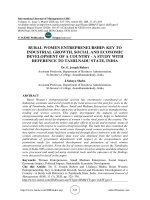Economic growth and economic development 652
Bạn đang xem bản rút gọn của tài liệu. Xem và tải ngay bản đầy đủ của tài liệu tại đây (125.81 KB, 1 trang )
Introduction to Modern Economic Growth
Standard arguments imply that the value function for a firm that is n steps
ahead (or −n steps behind) is given by
(14.51)
r (t) Vn (t) − V˙ n (t) = max{[Πn (t) − w∗ (t) G (zn (t))]
zn (t)
¡ ∗
¢
+zn (t) [Vn+1 (t) − Vn (t)] + z−n
(t) + κ [V0 (t) − Vn (t)]}.
In steady state, the net present value of a firm that is n steps ahead, Vn (t), will also
grow at a constant rate g ∗ for all n ∈ Z+ . Let us then define normalized values as
vn (t) ≡
(14.52)
Vn (t)
Y (t)
for all n which will be independent of time in steady state, i.e., vn (t) = vn .
Using (14.52) and the fact that from (14.32), r (t) = g (t) + ρ, the steady-state
value function (14.51) can be written as:
(14.53)
¡
¢
ρvn = max{ 1 − λ−n − ω ∗ G (zn ) + zn [vn+1 vn ] ,
zn
Ê
Ô
+ zn
+ [v0 − vn ]} for all n ≥ 1,
∗
is the equilibrium value of R&D by a follower that is n steps behind, and
where z−n
ω ∗ is the steady-state labor share (while zn is now explicitly chosen to maximize
vn ).
Similarly the value for neck-and-neck firms is
(14.54)
ρv0 = max {−ω ∗ G (z0 ) + z0 [v1 − v0 ] + z0∗ [v−1 − v0 ]} ,
z0
while the values for followers are given by
ρv−n = max {−ω ∗ G (z−n ) + [z−n + κ] [v0 − v−n ]} .
z−n
It is clear that these value functions and profit-maximizing R&D decision for followers should not depend on how many steps behind the leader they are, since a single
innovation is sufficient to catch-up with the leader. Therefore, we can write
(14.55)
ρv−1 = max {−ω ∗ G (z−1 ) + [z−1 + κ] [v0 − v−1 ]} ,
z−1
638









